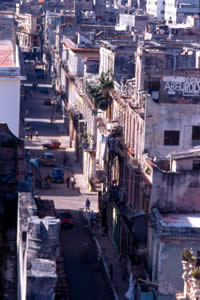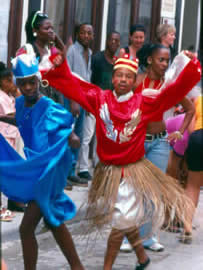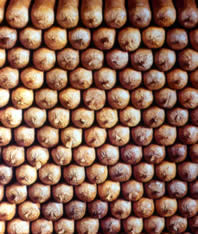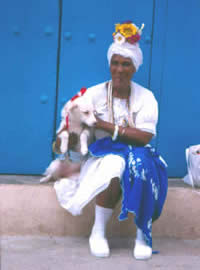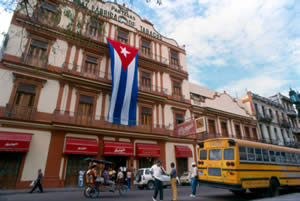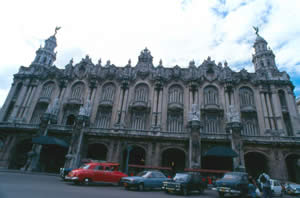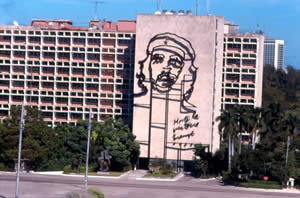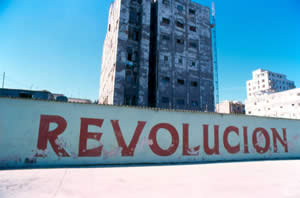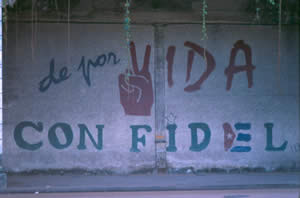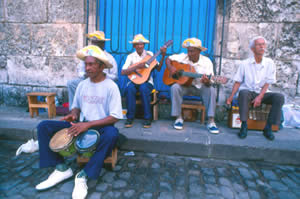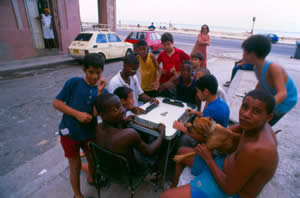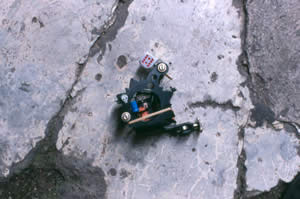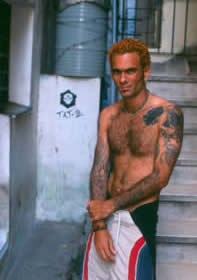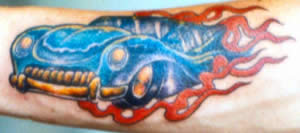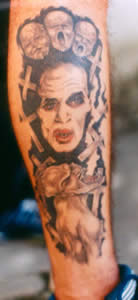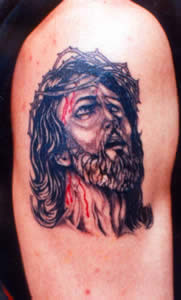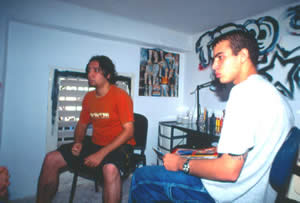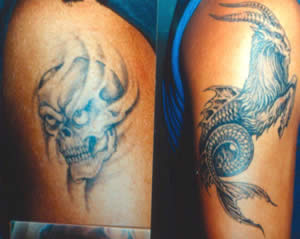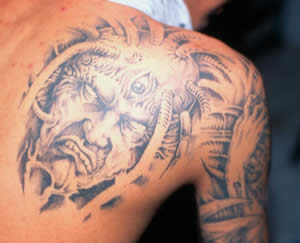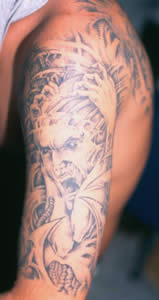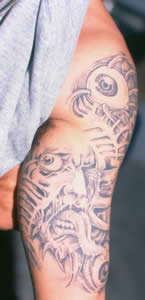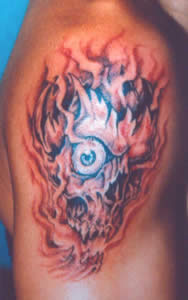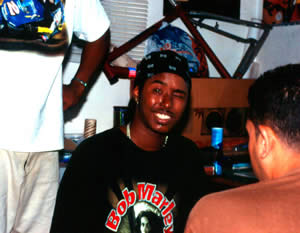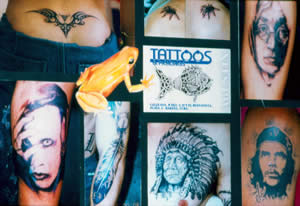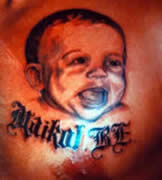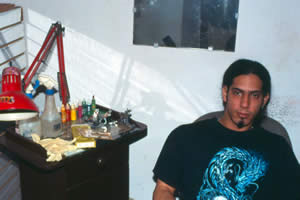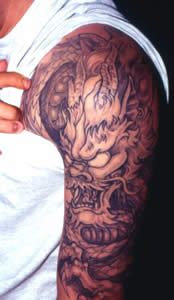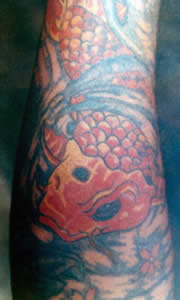
FOUR TATTOO ARTISTS IN HAVANA
© 2005 by Lars Krutak Whether you're harbored in Cancun or Montego Bay or simply seek a subversive siesta south of the Straits of Florida, Cuba could be for you-especially if you're thinking about getting inked by some of the most innovative artists in the Caribbean. Arriving on the eve of the anniversary of the Revolution (January 1, Liberation Day), I passed along timeworn colonial streets in a rickety red '57 Chevy taxi. With the rich, moist, warm Cuban air and exhaust fumes blowing into the backseat, I felt a bit dizzy and exited to find a sweet rum filled mojito at a corner bar, a salsa band pulsing frenzied rhythms to the enjoyment of the patrons. I puffed on a Cohiba, sat back, relaxed and began to understand why Ernest Hemingway spent the better part of his life living and writing here. It's awesome, amigo! Founded in 1515, Havana is one of the oldest cities in Cuba and, at two million, it's also the largest. Covering some 250 square miles, the urban sprawl and pollution is at first overwhelming, but like all fine cities, Havana is a collection of dozens of neighborhoods (barrios), each with its own distinctive flavor and charm. The oldest barrio, Habana Vieja, is the beating heart of the city and home to many historic buildings, churches, and monuments, most dating to the 16th and 17th centuries. And once you set foot here, you'll discover that most Cubans endure a life very different than that depicted in the Western media. Although you'll find yourself condemning the government at times (and maybe your own, if you're American), you will fall in love with the country and its people. Cubans relish a passion for pleasure and this groove is certainly addictive. PERSPECTIVES OF THE CUBAN TATTOO SCENEIn the 1960s and '70s, tattooing had criminal associations and it was not desirable by the majority of the population. Tattoo studios were largely underground operations and the government cracked down on the ones it could find. By the late 1980s, these attitudes changed, as popular culture dictated that tattooing was cool and here to stay. The government began to concede, however rigidly. They felt that tattooing was an art form, deciding it was better to tax tattooists to some degree, but only after influencing them to join government-run "artists associations." Still the police could show up on an artist's doorstep and take away their equipment, if they felt like it-especially if the work was gang or drug related. They even went so far as to outlaw the private ownership of an autoclave, a rule that exists today. Nevertheless, tattooists continue to use their contacts at home to buy busted autoclaves from discriminating hospital officials and have them refurbished by friends. Today, there are approximately ten noted tattooists in Havana, each with their own style and reputation. But many of the older guard fled to Europe or North America in the mid-'90s, because they could make much more money tattooing there, and, more importantly, they could get the supplies they needed without the hassles of U.S.-imposed embargoes or Cuban governmental prohibitions. Although de facto illegal (there are no studio advertisements in the yellow pages), tattooing seems to have been finally accepted by the Cuban government as a profession, especially since I noticed a couple of tattooed policemen in the street, one fine day! But in this country of contradictions, life, like work, is never what it seems. The Cuban government allows tattoo artists to operate, but only under the tenuous cover of "artist," that is, as long as they pay their annual dues to the Asociacion Hermanos Sais (a youth arts organization under the Ministry of Culture) and keep their membership cards updated. "Your card covers you as an artist, then you can tattoo [without governmental interference]," as one tattooist (Ché Alejandro) put it. Occasionally, foreigners attempt to set up tattoo studios under the guise of a "local" establishment of Cuban tattooists, but these are usually snuffed out by the police, and the "imperialist" operator is forced to sell out and leave the country. Actually, these instances are fortuitous for some locals, like the talented Agustín, who purchased the majority of his tattoo equipment from an Italian imperialist who was forced out of Cuba several years ago. Interestingly, over the past three years, there have been six mini tattoo conventions in Havana, showcasing the talents of artists from around the country. They are held over the course of a week at the Centro Artistico in Havana, and the last one was in spring 2004. These expos are advertised locally on radio and attended by old and young aficionados alike. Unfortunately, according to Ché, "the association of artists doesn't allow you to make money at the expo, only to promote your work."
THE ARTISTS
First off, locating tattoo artists in Havana is not as easy as you might expect. They are not listed on in the yellow pages or on the Internet. (Actually, Cubans are not allowed to browse the Internet, only to use e-mail. But tourists can do both whenever they want!) Hardly any of the artists have telephones. Some speak English, but, for the most part, they speak only Spanish. Basically, what you need to do is stop some tattooed streetwalker and hope she can point you in right direction! But once you get your headings, you'll find that each and every artist is an acquaintance and full of admiration for the others. I certainly did not get the feeling that there was any competition to speak of, especially since many of these guys helped each other to get their start in business. 1) Ché, 520 Tulipan, between Ayestaran Ché, at 31, is the "old man" of the Havana tattoo scene. When he's not skateboarding or surfing, he tattoos by appointment at his home studio "Tat-2" in Barrio Cerro. He's a carpenter by trade, but has spent the better part of the last 12 years tattooing in Havana. He works in all styles, sets no hours and prefers not to overwork, because he dislikes getting mentally tired. Most of his equipment (Spaulding and Unimax units, inks, spare coils) comes to him from his girlfriend when she visits from Missouri, U.S.A. But of course, he modifies most of his machines and has a friend in Havana named Ernesto who even manufactures his own brand. Ché is largely self-taught and started tattooing after drawing comic books when he was younger. This is evident in his flash sheets. When he started tattooing in the late 1980s "no one in Havana had tattoo machines-everyone pricked by hand." As for all of the other artists working in Havana, having outside contacts for supplies is essential, or you're out of business! But still, these contacts can only go so far, and they don't fully satisfy the need for more tattoo equipment. Case in point, Ché was desperately searching for a PULSE rebuild/repair collection when I spoke with him last. Ché loves his profession, his country, and his lifestyle. "I will never leave Cuba, nor will I stop tattooing." Like most tattooists, he derives an intense sense of purpose through his artistry and doesn't mind the fact that most of his local clients can't afford the premium prices fetched by tattooists elsewhere in the world. So, Ché is willing to work for much less than his North American counterparts. He makes up for this by inking tourists: "I find a lot of tourists coming here for ink," he says. "It's much cheaper than elsewhere in the Caribbean, and our work is as good as the next guy." When asked about the future of Cuban tattooing and its place in the world, Ché offered a brief, yet profound statement: "There are good tattooists in Cuba. We do art that lasts. Come here and see for yourself!" 2) Mikail Bonet, 202 Tamarindo, between Flores and Vega, Barrio Cerro
Mikail Bonet, 23, is known throughout Havana as the "biomechanical man." He has been tattooing for over four years out of his bedroom studio. He has always been drawing since he can remember. Ché, who lives a short taxi ride away, helped him get his start and to find his style. Mikail's father lives in Miami and assists with "under the table/embargo" tattoo supply when he can. Sometimes shipments have to be coordinated with other family friends in the Miami area. "Everything is a challenge in Cuba-supplies, inks, logistics. We simply have no access to them. Our postal system sucks or is nonexistent, so forget that method altogether!" I found that all tattooists in Havana use acupuncture needles for their machines. They are readily available for purchase at area hospitals. Other, more Western needles are far too expensive to purchase in Cuba and difficult to find anyway. Mikail picked up his taste for biomechanical work when browsing through some smuggled tattoo magazines showcasing the work of Paul Booth. "I really like Booth's work. He's solid and smooth." It seems that this genre is readily sought after by many of Mikail's clients, because I couldn't find any other examples of his work outside of the biomechanical style. Mikail doesn't advertise much, but attends the tattoo expos and hands out his cards. "Tattooing in Havana is a word of mouth kind of thing on the streets. If you're good, people will come. If you suck, you better find another line of work! It would be great to advertise in the yellow pages, but that would arouse too much governmental interest. I still have worries at night that the police might come and shut down my operation." Although tattooing is
still an underground profession in Cuba, every artist hopes to build a
first-rate tattoo studio in the future. As Mikail explains, "It's every
Havana tattoo artists' dream to have their own shop, but space is
expensive and the government would probably tax the hell out of us! But
on a more practical level, I could simply use some new supplies,
especially some tube cleaners for ink. Better yet, I would love to get
my hands on some new tattoo magazines, to get more ideas that I can
innovate upon. That is what I could use right now more than anything
else."
Some more examples of Mikail's surrealistic and biomechanical work. 3) Agustín Tattoos, 2114 Calle 60A, between 21 & 23, Barrio Buena Vista/Playa.
Agustín, 23, operates a lived-in studio out of his second story bedroom. When I caught up with him, he was doing a cover-up for Hector for $25 U.S. Agustín is self-taught, and what separates him from his colleagues in Havana is that he is the only tattooer who also pierces. No small accomplishment, since piercing supplies are harder to get than tattoo supplies! But lucky for Agustín, he has some admirers in Italy who occasionally send him gear. Still, he would be psyched if he could get his hands on a Micky Sharpz iron, because, "it's a better machine than the others. It's one of the best." Agustín has been sinking ink for nearly ten years, and he proudly displays the photo of his first tattoo session back in 1992 (he was 12!). He's been piercing for four years. Agustín has more flash than anyone in the city, and runs an efficient and popular business. When I arrived at his studio, a European tourist was waiting for some ink and several other locals where crashed on the mattress where Agustín sleeps. He has almost put the finishing touches on his new studio, which will double as a waiting room. It is located next to his bedroom. Agustín excels at portraiture, but he also tattoos tribal motifs and occasionally does cosmetic work. "It's not just young people who are getting tattooed here. Older people come in for cosmetic tattoos. Many people, young and old, come for a tattoo moment, with no predetermined design in their head. They just seize the moment to get inked. I love that spontaneity." And when I asked him what his message to readers would be, he replied, "In Cuba, we want to connect with the tattoo artists of the world. We want the world to know that there are innovative tattoo artists in Cuba, each with a unique style and feel for the art. We want share and learn from the best, but above all we want to ensure that Cuban tattoo survives." If Agustín's addictive enthusiasm and relish for tattooing is any indicator, I am sure that he will succeed, even if all others fail.
4) Sosa's Custom Tattoos, 268 Villegas, between Lamparilla and Obrapía, Old Havana.
As I approached the door of Sosa's Old Havana studio, three Bahamian men puffing torpedo-sized Cohibas were asking about a backpiece for one of their girlfriends. Sosa, 26, is the only tattooist operating in the historic city center near the touristy pedestrian mall Obispo Street, which is the most traveled thoroughfare in town. The location is awesome and Sosa draws more tourists than other artists operating in the city. Sosa, who speaks excellent English, knows the dirt on every tattooist in Havana and the suburbs and runs his little parlor out of the living room of his parents' home. You literally open the front door and walk into the studio. It's that simple. Sosa studied drawing before becoming a tattoo artist more than five years ago. His grandfather is a noted Cuban painter, and I'm sure he has drawn inspiration from his work. Sosa got his start with a notable Havana artist Junior Perez Carvajal, and he apprenticed with him for a year. But Junior soon left Havana for Italy, to cash in on business. He hasn't been back for several years. Although Sosa does have a Spaulding and Kaplan machine, he has more difficulty than others in attempting to find supplies. "When I first started, I spent one year looking for a machine. Flash is difficult to get, so I usually barter and trade for it. We cut samples from the magazines we get our hands on, but I could always use more." Sosa first worked with Chinese inks, but "they fade rapidly, and I wasn't impressed with the results. Today, I encourage my repeat clientele to use their contacts in Canada, Mexico and Europe to send ink and to bring it with them when they want a tattoo. It sucks to have to work this way, but most of the time it's my only option, although I am beginning to find more ink from Western sources." Sosa tattoos about 200 small pieces before he gets hired to do a sleeve or large backpiece. The problem is that most Cubans simply do not have much money to spend on larger pieces. When tourists come calling, they are, of course, charged slightly higher rates, but the work they get is still a bargain, no matter how you look at it. For large backpieces, expect the tourist rate of $150-200, sleeves $80-100 and smaller pieces $40. Sosa told me that there are two distinctive tattoo seasons when business is hot. "The two best tattoo seasons are during summer vacation (July and August), when everyone is ready for the beach to show off their new ink. Also, December-January is popular because almost everyone has a holiday during the Revolution celebrations and Christmas season." |
|||||||||||||||
|
Other tattoo articles by Lars Krutak
Vanishing Tattoo Home :: Tribal Tattoos Worldwide :: Online Tattoo History Museum © 2006 Lars Krutak |
